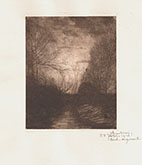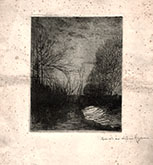Milan 1851 - 1920
Vittore Grubicy was the son of a Hungarian baron and a Lombard noblewoman. At twenty he began to travel and develop a knowledge of international naturalistic painting. In the early eighties he devoted himself to selling art, together with his brother Alberto. The two Grubicy brothers supported modern painting, encouraging the Scapigliatura artists. Vittore identified several young promising artists to follow - Segantini and Emilio Longoni - and pushed them toward the naturalism of Millet and the Barbizon school. In 1880 Grubicy resumed his travels - to Paris, England, and Low Countries - befriending artists of the Hague School, such as Henrik Willem Mesdag and Anton Mauve, who convinced him to devote himself to painting. He executed canvases and engravings. After 1891 he frequently travelled to paint on the high plains of the Verbano and Lario areas. His particular technique used a particle-like subdivision of tones to render transparent atmospheres, as well as emotions evoked by the harmonic effects of light and colour.


